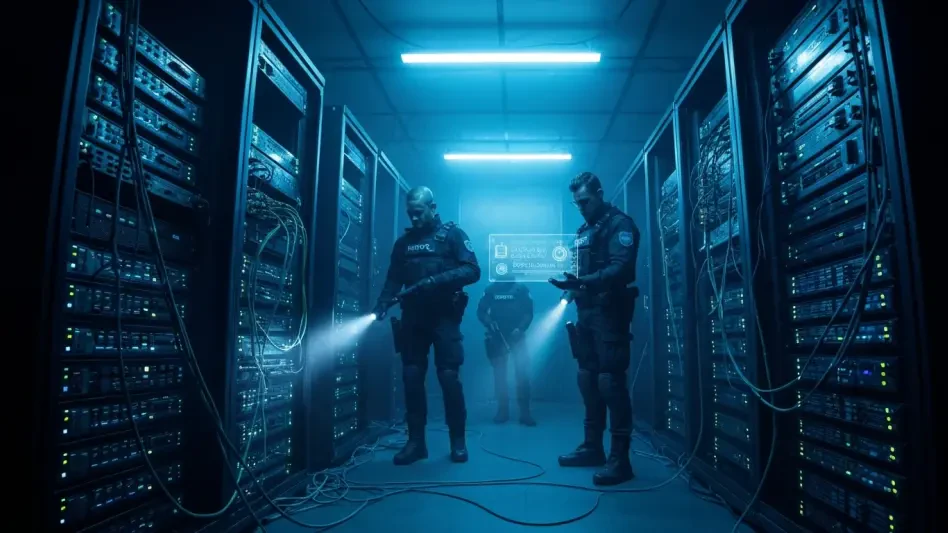In an era where warfare transcends physical battlegrounds and spills into the digital realm, the military cybersecurity market stands as a critical pillar of national defense, poised for staggering growth with projections indicating a rise to $56.99 billion by 2032. As state-sponsored cyberattacks, espionage, and advanced persistent threats (APTs) escalate, nations are compelled to safeguard their military networks, communication systems, and critical infrastructure with unprecedented urgency. The global market, valued at $15.70 billion in 2023, is on a steep trajectory, driven by the digitization of military operations and the increasing sophistication of cyber threats. This surge reflects a broader recognition that securing digital assets is as vital as traditional defense mechanisms. Projections indicate the market will climb from $18.12 billion in 2024 to an impressive $56.99 billion by 2032, highlighting the strategic imperative of cyber resilience. This article delves into the forces propelling this expansion, from geopolitical tensions to technological innovations, while exploring regional dynamics, emerging trends, and the competitive landscape. By examining these facets, a clearer picture emerges of how nations are fortifying their digital defenses against an ever-evolving array of cyber risks that threaten global security.
Surging Growth and Driving Forces
The military cybersecurity market is experiencing remarkable growth, with forecasts predicting a rise from $18.12 billion in 2024 to $56.99 billion by 2032, reflecting a compound annual growth rate (CAGR) of 15.4%. This rapid expansion underscores the critical role of cyber defense in modern military strategy as governments allocate substantial resources to protect their digital infrastructure. The stakes are high, with military operations increasingly reliant on interconnected systems for everything from logistics to real-time battlefield communications. Such dependency amplifies the need for robust security measures that can withstand sophisticated attacks designed to disrupt national security. The urgency to stay ahead of adversaries in this domain is palpable, as even a single breach can have catastrophic consequences for defense readiness and operational integrity.
A significant driver behind this market surge is the intensifying wave of geopolitical tensions across the globe. As nations engage in cyber espionage and digital skirmishes, military networks become prime targets for state-sponsored actors seeking to gain strategic advantages. These confrontations are not merely theoretical; they manifest in real-world incidents that expose vulnerabilities in defense systems. The growing prevalence of cyber warfare as a recognized domain of conflict further fuels demand for advanced security solutions capable of detecting and mitigating threats in real time. Governments are thus prioritizing investments in technologies that ensure the resilience of their digital assets against relentless and evolving dangers posed by hostile entities.
Technology as a Game-Changer in Cyber Defense
Technological innovation serves as both a catalyst and a challenge within the military cybersecurity market, reshaping how defense organizations approach digital threats. Artificial intelligence (AI) and machine learning (ML) are at the forefront, offering powerful tools for predictive analytics and automated threat response. These technologies enable military systems to anticipate potential vulnerabilities and react swiftly to incidents, significantly enhancing situational awareness. By processing vast amounts of data to identify patterns of malicious activity, AI-driven solutions are becoming indispensable for staying ahead of adversaries who deploy increasingly complex attack methods. The adoption of such cutting-edge tools marks a shift toward proactive rather than reactive defense strategies.
The integration of the Internet of Things (IoT) and cloud computing into military operations introduces additional layers of complexity to the cybersecurity landscape. IoT facilitates seamless data exchange across interconnected defense assets, from drones to command centers, improving operational efficiency. However, it also expands the attack surface, creating new entry points for cyber intruders. Similarly, cloud computing offers scalability and flexibility for managing military data but demands stringent security protocols to protect sensitive information from breaches. Balancing the benefits of these technologies with the risks they pose is a defining task for defense organizations, necessitating comprehensive solutions that secure every facet of digital operations without stifling innovation.
Segmentation and Key Market Categories
Understanding the military cybersecurity market requires a look at its segmentation by type, solution, end user, and region, each revealing distinct priorities and growth areas. Network security solutions currently dominate, given their essential role in protecting defense communication systems that underpin military coordination. These solutions are critical for ensuring that data transmitted across vast networks remains secure from interception or manipulation by hostile forces. As the backbone of military connectivity, network security garners significant investment to maintain the integrity of operations in an environment where even minor disruptions can lead to strategic setbacks. This segment’s prominence reflects the foundational importance of safeguarding communication channels against persistent cyber threats.
In contrast, endpoint security solutions are identified as the fastest-growing segment, propelled by the widespread use of mobile devices and unmanned systems in military settings. These endpoints, ranging from soldier-worn devices to autonomous vehicles, represent vulnerable points that adversaries can exploit to infiltrate broader networks. Meanwhile, among specific solutions, threat intelligence and response management hold the largest market share by providing actionable insights into emerging dangers. Identity and access management (IAM) is rapidly gaining ground, driven by the adoption of zero-trust architectures that mandate continuous verification of users and devices. These diverse segments illustrate the multifaceted nature of cyber defense needs across land, naval, and air forces, each requiring tailored approaches to address unique operational risks.
Regional Variations and Market Leadership
Regional dynamics play a pivotal role in shaping the military cybersecurity market, with North America leading due to its advanced defense infrastructure and substantial budgetary allocations. The United States, in particular, drives this dominance with extensive investments in securing military networks, satellite communications, and critical systems against digital threats. Collaborative efforts with technology leaders further bolster the region’s capabilities, ensuring that defense mechanisms keep pace with rapidly evolving cyber challenges. North America’s position as a market leader is reinforced by a strategic focus on cybersecurity as a core component of national defense, setting a benchmark for innovation and implementation that influences global standards.
Asia-Pacific emerges as the fastest-growing region, fueled by escalating geopolitical tensions and aggressive digitization initiatives in countries like Japan and South Korea. These nations are intensifying efforts to build cyber resilience amid regional uncertainties, investing in advanced technologies to counter state-sponsored threats. Europe, meanwhile, distinguishes itself with a strong emphasis on integrated defense programs and interoperability among allied forces. Countries such as Germany, France, and the UK are prioritizing collective security frameworks to address the transnational nature of cyber warfare. These regional disparities underscore how local priorities, threat landscapes, and economic capacities shape distinct approaches to bolstering military cyber defenses on a global scale.
Barriers to Market Expansion
Despite its robust growth trajectory, the military cybersecurity market faces formidable challenges that could impede progress if left unaddressed. High costs associated with deploying and maintaining advanced cybersecurity solutions present a significant barrier, particularly for nations with constrained defense budgets. Developing countries, in particular, struggle to afford the sophisticated systems required to protect against cutting-edge threats, risking a widening gap in cyber capabilities compared to wealthier counterparts. This financial hurdle complicates efforts to achieve widespread adoption of essential technologies, potentially leaving some military forces exposed to digital vulnerabilities that adversaries can exploit with relative ease.
Another pressing obstacle is the global shortage of skilled cybersecurity professionals capable of managing complex defense systems. The scarcity of experts, including cyber analysts and AI specialists, limits the ability to effectively counter sophisticated attacks that evolve at a rapid pace. Additionally, interoperability issues among disparate defense platforms hinder seamless integration of new security technologies, especially in multinational operations where allied forces must collaborate. These challenges necessitate innovative approaches, such as developing cost-effective solutions and expanding training programs to build a capable workforce. Overcoming these barriers is essential to ensure that the market’s growth does not falter amid rising cyber risks.
Trends Defining the Future of Cyber Defense
A transformative trend shaping the military cybersecurity market is the adoption of zero-trust security architectures, which operate on the principle that no user or device can be inherently trusted. This framework requires continuous verification, offering a robust defense against insider threats and sophisticated intrusions in cloud and distributed environments. As military organizations increasingly rely on decentralized networks, zero-trust approaches are gaining traction as a means to secure sensitive data and prevent unauthorized access. The shift toward this model reflects a broader recognition that traditional perimeter-based security is insufficient in an era of persistent and pervasive cyber threats, prompting a reevaluation of foundational defense strategies.
Equally significant is the growing emphasis on AI and machine learning as cornerstones of modern cyber defense. These technologies enable real-time threat detection, predictive analytics, and automated incident responses, empowering military systems to adapt to emerging dangers swiftly. Collaborative defense strategies are also on the rise, particularly in Europe, where initiatives focus on interoperability among member states to counter transnational cyber risks. Furthermore, investments in cyber training programs are addressing workforce shortages by equipping personnel with critical skills in areas like network monitoring. These trends collectively signal a strategic alignment toward proactive, technology-driven, and cooperative approaches to securing military digital ecosystems.
Competitive Forces and Industry Innovations
The military cybersecurity market is characterized by intense competition, with established defense contractors like Lockheed Martin and Raytheon Technologies holding significant sway through their expertise and long-term government partnerships. These industry giants leverage advanced technologies, such as AI-based threat detection and cyber ranges, to deliver comprehensive solutions tailored to military needs. Their ability to secure substantial contracts reflects a deep integration into national defense frameworks, ensuring that they remain at the forefront of addressing complex cyber challenges. This dominance is underpinned by a commitment to continuous innovation, aligning their offerings with the evolving demands of modern warfare in the digital domain.
Emerging players, including startups like Cyfirma and Shift5, are injecting fresh dynamism into the market with specialized offerings that challenge traditional approaches. These newer entrants focus on niche areas such as predictive cyber intelligence and operational technology protection for military assets like aircraft and tanks, demonstrating agility in addressing specific vulnerabilities. Recent developments, such as a notable $200 million contract awarded by the U.S. Department of Defense to a tech firm for AI tools in the current year, highlight the increasing importance of public-private collaborations. This competitive landscape, blending the strengths of legacy firms with the innovation of newcomers, fosters a vibrant ecosystem where adaptability and technological advancement are paramount to meeting military cybersecurity demands.
Path Forward for Global Cyber Resilience
Looking back, the military cybersecurity market had already shown its critical importance by growing from a valuation of $15.70 billion in 2023 to $18.12 billion in 2024, setting the stage for its projected leap to $56.99 billion by 2032. The journey revealed how escalating cyber warfare and geopolitical tensions had compelled nations to prioritize digital defense as a fundamental aspect of military strategy. Technological advancements, including AI and zero-trust frameworks, had begun transforming how threats were detected and mitigated, while regional leaders like North America, Asia-Pacific, and Europe each carved distinct paths based on their unique challenges and capabilities. Challenges such as high costs and talent shortages had tested the market’s resilience, yet the competitive interplay between established giants and innovative startups had driven remarkable progress.
Moving forward, the focus must shift to actionable strategies that address persistent barriers while capitalizing on emerging opportunities. Nations should invest in scalable, cost-effective solutions to ensure broader access to advanced cyber defenses, particularly for resource-constrained regions. Expanding global training initiatives will be crucial to bridge the skills gap, equipping a new generation of professionals to tackle sophisticated threats. Strengthening international partnerships can enhance interoperability, enabling allied forces to present a united front against transnational cyber risks. By fostering innovation through continued public-private collaboration, the military cybersecurity market can evolve into a robust shield for national sovereignty in an increasingly contested digital landscape.








